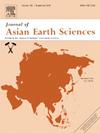Insights into tectonic lineaments patterns and crustal architectures beneath the Carlsberg Ridge: Implications for mineral exploration
IF 2.4
3区 地球科学
Q2 GEOSCIENCES, MULTIDISCIPLINARY
引用次数: 0
Abstract
This study focuses on the Carlsberg Ridge’s complex geological structures, characterized by rugged topography, seismicity, and significant hydrothermal activity, which have led to the deposition of economically valuable sulfide minerals. Using an integrated geophysical approach, including gravity data analysis, lineament mapping, Euler depth estimation, seismicity analysis, and spectral depth examination, we investigate the structural and crustal architecture beneath the Carlsberg Ridge. The analysis utilizes high-resolution GECO global gravity models, to generate detailed subsurface images. A comparative study of GECO-derived and shipborne Free-air gravity data shows strong agreement, with higher correlation and lower RMS error. The study also employs the regional-residual gravity separation, edge enhancement filters, and Euler deconvolution method, which aid in identifying mineralization zones and active/inactive vent sites conducive to mineral accumulation. Results indicate topographic and gravity anomalies linked to shallow-to-moderate depth discontinuities, active tectonics, hydrothermal venting, and mineralization processes. Identified zones shows high lineament density, moderate crustal thickness, and shallower Moho depths. The THVH technique delineated faults and fractures with dominant orientations of NE-SW, NW-SE, ENE-WSW, N-S, and E-W directions, respectively. Seismic events along the ridge axis, with focal depths of 9.0–10.5 km and magnitudes of 4.0–5.9 Mb, correlate with these zones. Mineralized areas align with high seismicity, shallow crustal features, and hydrothermal vent activity. These findings emphasize the Carlsberg Ridge’s potential for deep-sea mineral exploration, offering valuable insights into seafloor mineralization processes. This study provides a foundation for future geophysical and geochemical surveys in mid-oceanic ridge environments.

嘉士伯海岭下构造轮廓模式和地壳结构的洞察:对矿产勘探的启示
本研究的重点是嘉士伯岭复杂的地质构造,其特征是崎岖的地形、地震活动和显著的热液活动,这些都导致了具有经济价值的硫化物矿物的沉积。采用综合地球物理方法,包括重力数据分析、剖面测绘、欧拉深度估计、地震活动分析和频谱深度检测,研究了嘉士伯海岭下的构造和地壳结构。该分析利用高分辨率GECO全球重力模型,生成详细的地下图像。geco数据与船载自由空气重力数据的对比研究表明,两者具有较高的相关性和较低的均方根误差。利用区域-残余重力分离、边缘增强滤波和欧拉反褶积方法,识别矿化带和有利于矿物聚集的活动/不活动喷口部位。结果表明,地形和重力异常与浅至中深度不连续、活动构造、热液喷口和矿化过程有关。识别带显示出高的线密度、中等的地壳厚度和较浅的莫霍深度。THVH技术分别圈定了NE-SW、NW-SE、ENE-WSW、N-S和E-W方向为主的断裂和裂缝。震源深度为9.0-10.5 km,震级为4.0-5.9 Mb的沿脊轴地震事件与这些带相关。矿化区与高地震活动性、浅地壳特征和热液喷口活动相一致。这些发现强调了嘉士伯岭深海矿产勘探的潜力,为海底矿化过程提供了有价值的见解。该研究为今后大洋中脊环境的地球物理和地球化学调查奠定了基础。
本文章由计算机程序翻译,如有差异,请以英文原文为准。
求助全文
约1分钟内获得全文
求助全文
来源期刊

Journal of Asian Earth Sciences
地学-地球科学综合
CiteScore
5.90
自引率
10.00%
发文量
324
审稿时长
71 days
期刊介绍:
Journal of Asian Earth Sciences has an open access mirror journal Journal of Asian Earth Sciences: X, sharing the same aims and scope, editorial team, submission system and rigorous peer review.
The Journal of Asian Earth Sciences is an international interdisciplinary journal devoted to all aspects of research related to the solid Earth Sciences of Asia. The Journal publishes high quality, peer-reviewed scientific papers on the regional geology, tectonics, geochemistry and geophysics of Asia. It will be devoted primarily to research papers but short communications relating to new developments of broad interest, reviews and book reviews will also be included. Papers must have international appeal and should present work of more than local significance.
The scope includes deep processes of the Asian continent and its adjacent oceans; seismology and earthquakes; orogeny, magmatism, metamorphism and volcanism; growth, deformation and destruction of the Asian crust; crust-mantle interaction; evolution of life (early life, biostratigraphy, biogeography and mass-extinction); fluids, fluxes and reservoirs of mineral and energy resources; surface processes (weathering, erosion, transport and deposition of sediments) and resulting geomorphology; and the response of the Earth to global climate change as viewed within the Asian continent and surrounding oceans.
 求助内容:
求助内容: 应助结果提醒方式:
应助结果提醒方式:


